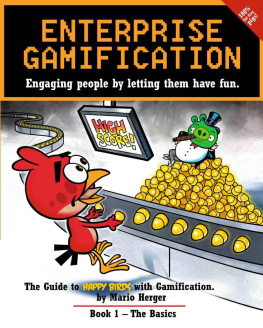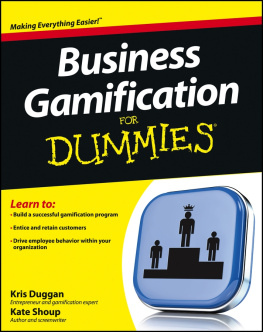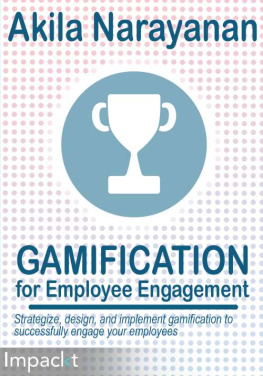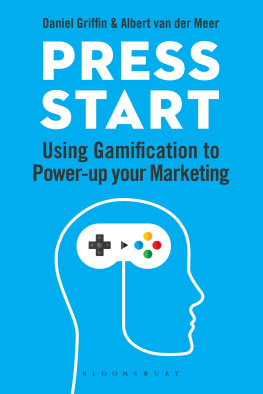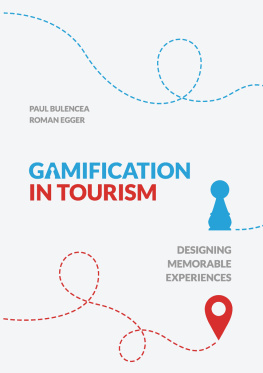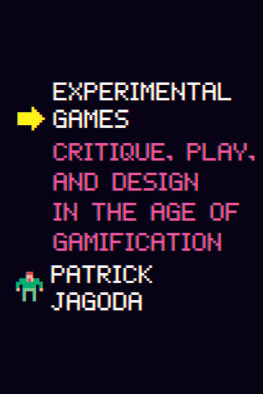Enterprise Gamification
Engaging people by letting them have fun
Book 1
The Basics
Mario Herger
Copyright 201 4 Mario Herger
All rights reserved.
ISBN: 1470000644
ISBN-13: 978-1470000646
DEDICATION
This is my fifth book,
And I dedicate it to my wife Natasha and my son Sebastian,
Who bought the other four.
And to my twin baby-boys Gabriel and Darian,
Who use it for age-appropriate purposes.
NOM NOM
CONTENTS
Mission 0 Game Trailer
Mission 1 Onboarding
Definition
Gamification History
Gamification Areas
The Gamification Tipping Point
Where Work and Game are Similar
Gamification Criticism
Leveling Up from Gamification to Enterprise Gamification
Success and Failure Rates
Facts & Figures
Mission 2 The Challenge
Defining the Challenge
How to make people care
Mission 3 The Player
The User
Player Dimensions
Character Dimensions for Movies
Persona Example
Mission 4 Motivation and Habit
Motivational Theories
The Art of Failure
Emotion
Engagement
Monotony
Boredom
Habits
Mission 5 Design Elements
Game Mechanics and Game Rules
Gamification Design Elements
Mission 6 Design Process
Gamification Design Thinking
Balancing
Duration and Frequency
Cheating and Gaming the System
Reward System Examples
Analysis of Applied Gamification Design Elements
Mission 7 Metrics, Scores and Data
Metrics
Gamification Data and Standards
Scores
Big Data
Mission 8 Laws and Regulations
Legal
Compliance
Policies and Governance Models
Legal Tips for Gamification
The Dark Side
Mission 9 Lifecycle and Strategy
Lifecycle
Strategy
Gamification Decision Engine
Mission 10 Game On, Level Up!
About the Author
Appendix
Index
Tables
Images
Contents
References
ACKNOWLEDGMENTS
This book would look very different without the diligent editing of my friend Mark Schreiber. His knowledgeable feedback on the topic guided me from rants and repetitions to a friendlier and more legible writing style. Not least I want to thank him for going through the painful exercise of correcting my Austrian English.
A book sells either through its title, its cover, or both. In this case Bernd Ertl, an excellent Austrian cartoonist , created this great cover. He does really fantastic work that I ask you to check out on his website http://www.ausgezeichnet.com/
Finally , let met thank you all of you who have inspired me with their awesome work and enthusiasm in all the fields that are the basis for gamification and making the world a better place. Many of you and your work are quoted in this book.
Mission 0 Game Trailer
What matters is not how motivated someone is, but how someone is motivated.
Alfie Kohn
Whats your computer wallpaper? A picture of your family, a dream vacation spot, your pet, your favorite sports team? Whatever it is, its probably not a picture of your job. Which is why I was so surprised when I visited the BMW plant in Dingolfing, Bavaria many years ago to do so me programming work.
A s we were walking through the factory floor, the buzzing and humming surrounded us. We found ourselves thrown into a chaotic, yet orderly dance of humans and robots around sculptures of metal, glass, and cables to craft what would soon become some of the most adored cars in the world. When we finally passed the three-stories high shelves with hundreds of neatly stacked engine blocks, we had reached the office of the IT manager. From his Spartan room with a staggering view of the assembly line, he took care of the smooth operation and upgrades of all IT workstations at the quality check points in the assembly hall. When we finally turned our attention from the cars, our eyes fell on the background picture on his monitor.
Is this the new BMW 5 design? one of us asked.
The IT manager looked at the image.
Yes, Marketing just released the images today to the public, he said. And then, after a long pause, without having taken his eyes from the picture, he added with a trembling voice, Its really a beautiful car.
This was motivation on a level that I have only rarely seen again in the next two decades. At least not at work, but Ive met that look again in video game players. Like the girl in Figure 1 playing a video game . Her face tells us that she is enjoying the game, that she is focused and that she seems to be winning. Yes, somehow she seems to be beating the crap out of a monster, or a dragon, or whatever opponents she is fighting right now. Nothing can distract her; she is in the flow and she experiences fiero, her personal triumph. But she does not look like she is relaxing. It looks more like the total opposite; she is working hard.

Figure 1: A video game player ( Philip Toledano)
Now i magine a user interacting with your application; or you interacting with any non-game system and process. What would the picture look like? Build up this mental image. What do you see? The facial expression looks probably very different. Passive, disengaged, perhaps frustrated or even angry.
While this girl is at a very high level with engagement, fun, and the hope to be successful, the very same attributes with business applications tend to be at a low level. And this is our quest: to understand how can we give our users an experience that resembles the one that players have?
Most likely , we will never reach or surpass the levels of engagement for employees that videogames can achieve, but if we can improve the current level a little bit, could we get more work done?
For most employees, work is pretty boring. Work for them is something that they dread, an obligation that has locked them in an inescapable situation, from which they try to get as far as possible in their times off. Maybe you are a person like that right now. If not, youve certainly met such a person: the unhappy cashier at your supermarket, the rude clerk at a ticket counter, your colleague on the other side of your cubicle whos spending most of the time walking with his mug between the coffee corner and desk.
And once in a while you catch those very same co-workers at their true passion. The bored clerk turns out to be very creative in building the most elaborate model train sets, or the cashier whos helping with wedding planning on the side and doing really creative event decorations. Our first reaction with such unexpected revelations is surprise, and then the second the question: Why cant they bring this passion back to work?
I was buying groceries in a supermarket in my home town of Vienna, when I encountered a cashier who seemed to fall out of the usual pattern of reserved friendliness paired with low engagement that is usual in this demanding but low paid job. This cashier kept chatting with the customers, looking at the products that they had put on the counter, asked them about their opinion and generally showed an upbeat mood. The customers were caught off-guard, and reacted reserved until their resistance whittled away. And lo and behold, within a short time, the supermarket shoppers who typically minded their own business were engaged in chatting with her. The shoppers kept coming to this supermarket searching for her and lining up in her line, although it took longer to get through, But that was outweighed by the opportunity to get a dose of cheerful mood from her.
According to a long-running Gallup -study , the levels of engagement are at a devastating low. Seventy percent of employees in the US are not engaged. The researchers state that

